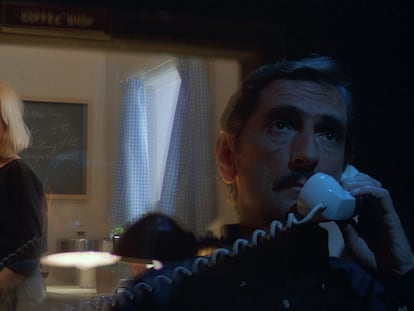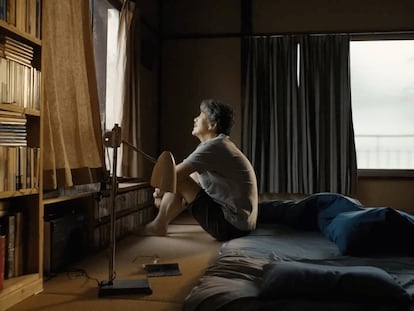The Tokyo toilets that inspired Wim Wenders’ Oscar-nominated film ‘Perfect Days’
The latest release from the German director pays tribute to a unique bathroom-themed design project involving 17 major names in architecture
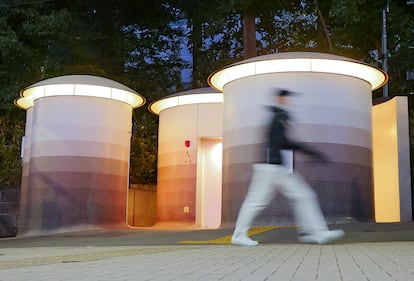
Perfect Days, the latest film by Wim Wenders, which was nominated for Best International Film at the 2024 Oscars, has not only aroused admiration for its production and plot, but also for the environment in which it takes place: the set of 17 high-tech public bathrooms built in two parks in central Tokyo where the protagonist of the story works as a cleaner — a collection of small architectural gems located in the Shibuya district, one of the urban areas most photographed by Western tourists in the capital city, thanks to its famously crowded crosswalk, immortalized in films such as Lost in Translation, by Sofia Coppola, or Babel, by Alejandro González Iñárritu.
“My idea was to create facilities open to anyone regardless of gender, age, nationality or disability,” explained Koji Yanai, creator and owner of the project, and a producer of Wenders’ film, in an email to EL PAÍS.
He mentions a conversation with his father, Tadashi Yanai, founder of the multinational fashion company Fast Retailing, owned by Uniqlo, who told him: “It’s good to have a particular focus, but the most important thing is to make something for everyone.” From there, Koji Yanai decided to help with the organization of the Tokyo 2020 Paralympic Games, by “addressing a fundamentally human issue”: the need to use the toilet.
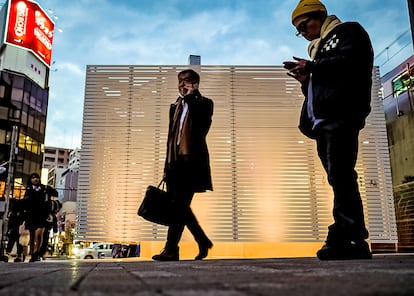
To counter the negative image of the public toilet “as a dark, smelly, scary, hard-to-find place,” Yanai called on well-known creators to redesign “public toilets that everyone would want to use.” In collaboration with the private non-profit Nippon Foundation and the local government of Shibuya, the result is a blend of public art, technology and hygiene called The Tokyo Toilet (TTT).
Creative and functional solutions
The spaces are a showcase of creative and functional solutions signed by 16 renowned designers, academics and architects, such as Fumihiko Maki, Tadao Ando and Shigeru Ban, Pritzker Prize winners in 1993, 1995 and 2014, respectively.
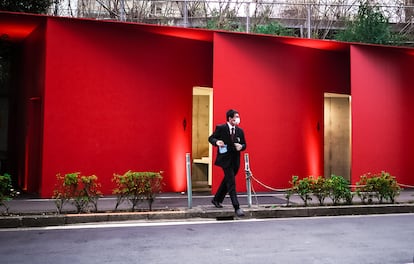
Each of the rooms features toilets by TOTO, a pioneer in electronics applied to restrooms, whose extreme sophistication surprises foreign visitors, enriching their anecdotes from their visit to Japan. The toilets that Hirayama, the protagonist of Perfect Days, cleans every day are an ideal way to get to know the project. The one closest to Shibuya station, in Jingu-Dori Park, is a metal structure designed by Tadao Ando that resembles a circular object from another planet that has just landed in a Japanese cherry orchard. Its overhanging roof evokes the eaves of the traditional Japanese house that extends into the garden and serves as a transition between the living area and nature.
The most talked about toilets, because of their unusual design concept, are the ones with transparent walls designed by Shigeru Ban in two adjacent parks in the Yoyogi neighborhood. When the user closes the door and locks it, the walls become opaque. The idea is to be able to confirm from the outside whether the toilet is unoccupied and clean.
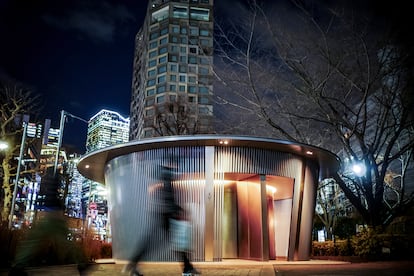
The washbasins designed by Toyo Ito, architect of the Porta Fira Towers in Barcelona, are located in front of Hachimangu, the Shinto shrine where Hirayama’s character eats his daily snack and takes the opportunity to photograph the light filtered by the leaves of the trees. Ito designed three cylinders crowned with respective domes, creating an ensemble reminiscent of the mushrooms that grow in the temple gardens.
Thinking about the urgency associated with finding a restroom when walking through an unfamiliar place, product designer Nao Tamura chose vermilion red for the exterior of her construction, which is a triangular structure located on a narrow plot of land next to the rail line. The metal walls, which mimic paper, are a tribute to a traditional Japanese method of wrapping gifts and offerings.
In the elegant Shoto neighborhood in Tokyo, where, in the film, a mother hurries to disinfect her son’s hands after touching Hirayama, is a project by Kengo Kuma, the most sought-after Japanese architect of the moment, and the designer of Japan’s National Stadium, where the Tokyo 2020 Olympic Games were inaugurated. Called A Walk in the Woods, in English, it is composed of five hut-like modules topped with pieces of cedar, in line with the architect’s tendency to give visual prominence to natural materials.
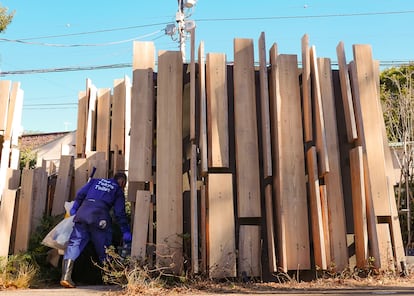
The most used restroom of all is the one designed by Kashiwa Sato at the west exit of Ebisu Station. It is a set of four toilets wrapped in a lattice that allows users to see whether someone is entering or leaving. Sato, a regular designer for Uniqlo’s corporate communications, created the pictograms that mark all TTT spaces.
Yanai, the project’s creator, refuses to say which toilet is his favorite. “It’s like choosing your favorite child,” he says, and instead shares the main lesson he took from the working on the project: becoming aware of the importance of cleaners and maintenance work. “Even if it’s a fantastic toilet designed by a famous creator, if it’s not kept clean, people will naturally stay away from it,” he explains, and connects his production of Perfect Days to his intention to showcase the people who work to ensure that toilets stay sparkling clean.
Training with workers
To learn how to clean toilets equipped with integrated circuits and master the use of a hand mirror to facilitate inspection, the actor who plays Hirayama, Koji Yakusho, trained with employees of the company in charge of maintenance, Tokyo Sanitation. The complexity of the design of TTT’s toilets and the variety of materials require the use of special methods, tools and, in some cases, detergents designed for each particular toilet, according to Haruhiko Watanabe, a manager at Tokyo Sanitation.
For Koji Yakusho’s performance in Perfect Days, Watanabe explained the correct posture for a craft more familiar to older generations in Japan, who were taught how to regularly clean their own classrooms and bathrooms in school.
Sign up for our weekly newsletter to get more English-language news coverage from EL PAÍS USA Edition
Tu suscripción se está usando en otro dispositivo
¿Quieres añadir otro usuario a tu suscripción?
Si continúas leyendo en este dispositivo, no se podrá leer en el otro.
FlechaTu suscripción se está usando en otro dispositivo y solo puedes acceder a EL PAÍS desde un dispositivo a la vez.
Si quieres compartir tu cuenta, cambia tu suscripción a la modalidad Premium, así podrás añadir otro usuario. Cada uno accederá con su propia cuenta de email, lo que os permitirá personalizar vuestra experiencia en EL PAÍS.
¿Tienes una suscripción de empresa? Accede aquí para contratar más cuentas.
En el caso de no saber quién está usando tu cuenta, te recomendamos cambiar tu contraseña aquí.
Si decides continuar compartiendo tu cuenta, este mensaje se mostrará en tu dispositivo y en el de la otra persona que está usando tu cuenta de forma indefinida, afectando a tu experiencia de lectura. Puedes consultar aquí los términos y condiciones de la suscripción digital.
More information
Archived In
Últimas noticias
All the effects of gentrification in one corner of Mexico’s Colonia Roma
Palestinian reporter Youmna El Sayed: ‘My family told me I had to choose between being a journalist or a mother’
The new language of the workplace: Knowing how to ask AI questions is more important than using it
Russell Tovey: ‘I was advised many times not to come out, I don’t think there was many people who’d done that — and I feel really proud that I’m one of those that did’
Most viewed
- The low-cost creative revolution: How technology is making art accessible to everyone
- Christian Louboutin: ‘Young people don’t want to be like their parents. And if their parents wear sneakers, they’re going to look for something else’
- US sanctions against jailed cartel leader ‘El Marro’ highlight Mexico’s lack of control over its prisons
- Liset Menéndez de la Prida, neuroscientist: ‘It’s not normal to constantly seek pleasure; it’s important to be bored, to be calm’
- Cartels in Mexico take a leap forward with narco-drones: ‘It is criminal groups that are leading the innovation race’

